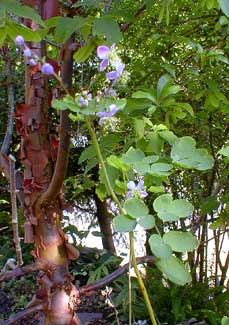
Lavender Mist Meadow Rue
Thalictrum rochebrunianum (formerly T. dipterocarpum), a native of Japan, is one of the hardiest of the Meadow Rues, although it can be fragile in even the most moderately dry conditions, requiring consistent moisture to look its best. Ours grows at the foot of the Paperbark Maple, because my thinking had been that the tendency for meadow rues to get six feet tall then tip over would be mitigated by having it reach up & brace itself among the Paperbark's lower limbs.
This did have the desired effect. T. dipterocarpum is less tippy than most species, & with limbs as braces it remains very upright indeed. However, meadow rue does not compete well for water resources, & because I sometimes fail to give extra water to the meadow rue, it has not in two years gotten especially elegant, not when I compare it to some really lovely meadow rues I've seen here & there. I do think the paperbark is getting the lion's share of the water.
It is not unusual for meadow rue to take three years to establish itself nicely, & a clump will even then not have spread very much. So my fingers are crossed that it will develop into an ideal clump of meadow rue rather than the minor pleasure it has been for two years.
Last year (2002) the leafcutter bees took an uncommon liking to this meadow rue, without touching another meadow rue (T. delavayi) growing on the opposite side of the path. Of the scores of plants the bees could be cutting circles out of, they went for the Lavender Mist Meadow Rue in particular, as well as a Red Epimedium twenty-odd feet away, touching nothing in between. Usually the leafcutters are charming inhabitants who do no particular harm with their taking a bit of leaf matter here, a bit there, rarely enough to harm the looks of any one perennial or vine. They are ideal pollinators not to be discouraged. But summer of 2002, they really did a number on the meadow rue. Fortunately in 2003 the leafcutter bees did not focus so much energy on just this one plant.
It likes humusy soil, moist & well draining, in dappled sunlight. It is ideal for USDA zones 6-7, but with shorter season will grow down to zones 4, being cold-hardy at minus ten to zero degrees F. With a bit extra shade to protect it, it's fine for zone 8 & not impossible for zone 9. It is highly intolerant of humid heat so probably not worth attempting further south or anywhere with hot humid summers.
It generally grows to six feet, though eight feet is not improbable, yet is so airy in its structure it does not overshadow or crowd out smaller perennials. In summer the tall lanky stems with ferny foliage bloom near the top, dangling sprays of small lavender-pink sepals with bright yellow anthers. Ours blooms primarily in July & August. In masses these blooms can have considerable impact, & really do look like a cloudy lavender mist. With just a single young plant such as we have, the impact is overly subtle, & one must remember to look for it blooming.
Some catalogs imply that "Lavender Mist" is a cultivar of T. rochebrunianum, but it is not a cultivar, it's just a discriptive common name to distinguish this Japanese wildflower from other species of gardenable meadow rues, of which there are many.